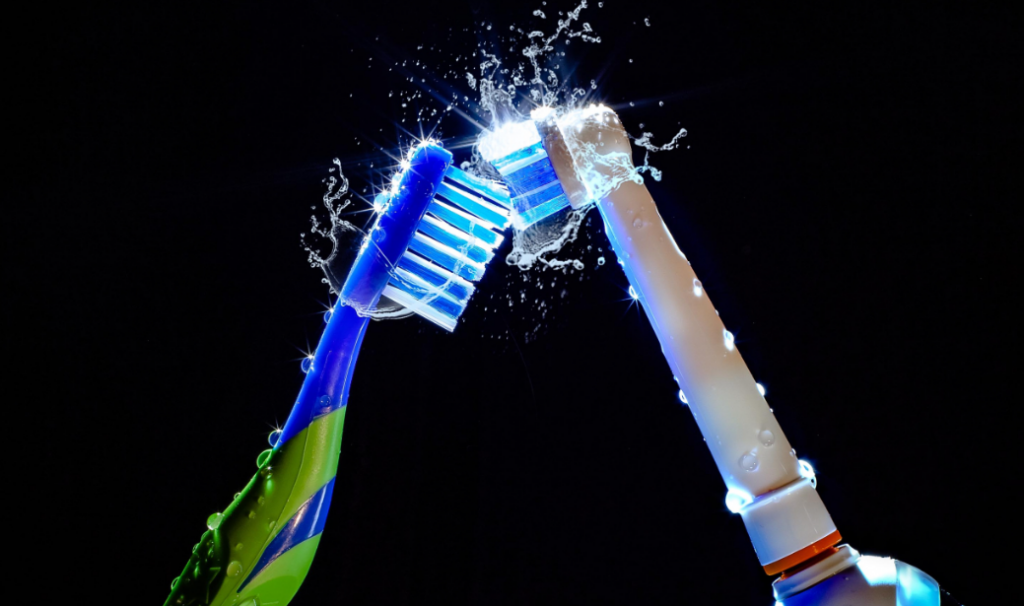Choosing between an electric and conventional toothbrush is an important decision that can affect your oral hygiene. Each type has its pros and cons based on different aspects of use, such as cleaning efficiency, convenience, cost, and impact on gum health. So which brush is better a conventional or electric brush?
Varieties of manual (conventional) brushes
Manual toothbrushes come in a variety of options, depending on the material and stiffness of the bristles:
- Very soft – ideal for people with gum disease and thin enamel.
- Soft – suitable for daily use for sensitive gums.
- Medium stiffness is the most versatile option and is recommended for most patients.
- Hard – designed to remove stubborn plaque.
- Combination and generic – combines different types of bristles for comprehensive care.
The choice of brush should be based on your individual characteristics and the recommendations of your dentist, who will be able to advise you on the optimal level of bristle stiffness based on your oral health.
Varieties of electric toothbrushes
Electric toothbrushes with rotating head
- These brushes are recommended for those who are looking for a more thorough cleaning without much effort on the part of the user. Their main advantage is their ability to clean hard-to-reach areas of the mouth with quality thanks to their small head size and rotational technology.
When choosing an electric toothbrush, you should look at:
- Type of head (removable or non-removable),
- Presence of a pressure sensor,
- Pairing with a smartphone is possible.
This will help to ensure safety and comfort of use, as well as allow you to control the cleaning process.
Ultrasonic toothbrushes
- Ultrasonic brushes are the pinnacle of innovation in oral care. They provide exceptional cleaning thanks to ultrasonic vibrations that effectively remove plaque without damaging enamel. It is important to remember that regardless of the type of brush, regularity and thoroughness are key.
Interdental brushes and brushes for braces
There are specialised brushes for people with special needs such as braces or implants. Interdental brushes help to clean the space between teeth, while braces brushes help to care for orthodontic appliances without damaging them.
Cleaning efficiency
Electric toothbrush
- Electric toothbrushes have rotating or vibrating heads that provide intense friction and reach hard-to-reach places in the mouth. Studies show that they can be more effective at removing plaque and reducing the risk of gum disease than conventional brushes. This is especially important for people with orthodontic appliances, as electric brushes can easily clean around braces and other orthodontic devices.
A regular toothbrush
- When used correctly and carefully, a regular toothbrush can also effectively remove plaque and massage the gums. However, it requires proper brushing technique, sufficient time and regularity, which can be difficult to follow for some people.
Convenience and accessibility
Electric toothbrush
- Electric toothbrushes require minimal effort to use, making them ideal for people with limited motor skills or those looking for a more convenient way to brush their teeth. However, they are more expensive to purchase and require replacement heads, which also increases the overall cost. Plus, they require access to electricity or battery replacement in order to use them.
A regular toothbrush
- Conventional toothbrushes are cheaper and more readily available, and are easy to find in any shop. They do not require electricity or batteries, making them convenient for travelling. However, brushing techniques must be carefully followed to be highly effective.
Impact on gum health
Electric toothbrush
- Electric toothbrushes are often equipped with pressure sensors that prevent too much pressure on the gums, thereby reducing the risk of gum recession and other problems. What’s more, some models offer special modes for sensitive gums and even help fight inflammation and bleeding.
A regular toothbrush
- Traditional toothbrushing requires a more careful approach to brushing to avoid damaging the gums. Heavy pressure and improper technique can cause gums to recede and damage enamel. At the same time, when used properly, a conventional toothbrush is quite capable of ensuring healthy gums.
The choice between an electric and conventional toothbrush depends on individual preferences, oral care goals, and budget. An electric toothbrush offers improved cleaning performance and additional gum health features, but requires a greater initial and ongoing investment. A conventional brush can be just as effective when used correctly, offering simplicity and affordability.
It’s important to remember that regardless of the type of brush you choose, regularity and proper use are key to maintaining healthy teeth and gums. Talk to your dentist about which type of brush is best for you, and don’t forget regular professional cleanings and check-ups.
This article is provided for informational purposes only and does not constitute professional medical advice. The recommendations and advice contained herein are not intended to replace an individual consultation with a dentist. Please consult a qualified professional for accurate oral care and toothbrush recommendations.
Discover the world of toothbrushes and enjoy savings with reBITme. Don’t miss your chance!





